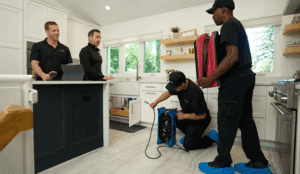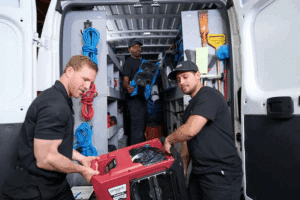The actual water damage to your home might be less stressful than dealing with the insurance claim itself. What should be a simple way to recover from disaster often becomes a maze of paperwork, assessments, and negotiations. Most homeowners and renters feel lost when they handle these claims without proper guidance.
Table Of Contents
- Understanding The Water Damage Insurance Claim Process
- How To Prepare Before Filing A Claim
- Working With Insurance Adjusters And Navigating The Process
- Conclusion
- FAQs
Dealing with water damage creates enough stress without adding insurance complications to the mix. DRYmedic has seen countless water damage homeowners insurance claims turn into complex ordeals. We created this detailed guide with water damage insurance claims tips to help you handle each step of the process smoothly. You’ll learn everything from your policy coverage details to working with a water damage insurance claims adjuster. This knowledge will help you tackle your claim confidently.

This piece breaks the whole process into simple steps. We address common issues with renters insurance claims, water damage cases and share professional tips to help you get the most from your claim. We want to give you the tools and knowledge to handle this process well and receive the compensation you deserve.
Understanding The Water Damage Insurance Claim Process
Water damage in your home starts a race against time for your insurance claim process. Quickly filing a water damage claim helps mitigate damage and prevents denial due to late reporting.
Your first step should be calling your insurance provider about the incident. They will create a claim file and usually send an adjuster within 24-48 hours. Taking photos and videos of the damage provides important evidence to support your claim.
The insurance adjuster examines your property during the assessment phase. This examination determines damage extent and policy coverage. Many homeowners struggle with policy language and coverage limits at this stage.
Your insurance company will present a settlement offer that details covered repairs. A careful review becomes vital since the original offers might not cover all damage costs.
Restoration professionals who understand insurance claims can make a major difference throughout this process. DRYmedic teams work directly with insurance companies to catch every detail. We help explain coverage questions, document damage accurately, and create detailed restoration estimates that insurance companies value.
Professional guidance often results in better claim settlements, so you don’t need to handle this complex process by yourself.

How To Prepare Before Filing A Claim
The right preparation can make a huge difference with water damage insurance claims. You should take these critical steps before calling your insurance company to build a stronger case.
Stop the water source if you can do it safely and move valuable items away from wet areas. Document everything about the damage with clear photos and videos from multiple angles. Show both the water source and affected areas clearly. This visual proof will be a great way to get support if any disputes come up later.
Your insurance policy needs a careful review to understand coverage limits and deductibles. Many homeowners find out too late about specific requirements or limitations for certain water damage scenarios.
A dedicated folder should contain records of all insurance company communications. Write down names, dates, and conversation details. Keep all emails and letters organized.
Insurance companies view claims more favorably when they include professional assessments. Our DRYmedic team becomes valuable here – our licensed professionals quickly survey damage and create custom restoration plans.

Our team works directly with your insurance company to process claims smoothly. Years of experience with water damage insurance claims adjusters have taught us the right documentation methods that insurance companies accept.
Good preparation doesn’t just make your claim faster – it helps you get more complete coverage for your water damage.
Working With Insurance Adjusters And Navigating The Process
Meeting a water damage insurance claims adjuster face-to-face can feel daunting. These professionals review damage, determine coverage, and calculate your settlement amount. Their decisions directly affect your recovery.
Our experience helping countless homeowners shows that being honest and transparent with your adjuster gets the best results. You should provide complete documentation and point out all damage areas without exaggerating.
Homeowners often find it hard to handle payment options and coordinate between multiple parties. We have developed a system that makes this process simpler. Our team works directly with your insurance company and other third parties. We coordinate the whole restoration process to ensure nothing gets missed.

Clear communication plays a vital role throughout the claims process. You need to keep detailed notes of conversations with your adjuster. Include names, dates, and the key points you discussed. Ask for clarification when something seems unclear, especially about coverage limitations or exclusions.
Note that adjusters handle many cases at once. Your claim moves forward smoothly when you stay organized and responsive. Having a restoration partner who understands insurance claims helps protect you better. We often spot coverage opportunities you might miss on your own.
Insurance companies value professional documentation and estimates. Our restoration professionals provide detailed assessments that insurance companies recognize. This helps prove your claim quickly.
Conclusion
Water damage in your home is stressful enough without dealing with insurance paperwork and negotiations. This piece highlights how good preparation and documentation build the foundation for successful insurance claims. Insurance companies look more favorably at well-documented claims that have professional assessments backing them.
Time isn’t on your side when water damage hits your home. Fast action helps minimize property damage and makes your claim stronger. Many homeowners get their claims denied because they wait too long to report damage or don’t document it properly.
It helps to know your policy coverage before disaster strikes. Most people only learn about coverage limits after water damage occurs. This creates needless stress and money worries. A quick policy review today could save you thousands tomorrow.
Water damage restoration and insurance claims might seem complex, but they’re easier to handle with the right guidance. We see it every day – homeowners who have knowledge and professional support get better results than those who try to direct the process alone. Our DRYmedic team handles these situations daily. We work directly with insurance companies and make sure nothing gets missed during restoration.
The gap between denied claims and full coverage often comes down to three things: documentation quality, professional assessment, and knowing how to work with adjusters. Think over working with restoration professionals who know insurance claims – this choice could determine how well you bounce back from water damage.
Your home needs proper protection and restoration after water damage. These insights will give you the confidence to handle insurance claims. You’ll know exactly what to do if water damage affects your property.
FAQs
What types of water damage are typically covered by homeowners insurance?
Most homeowners insurance policies cover sudden and accidental water damage, such as from a burst pipe. However, damage from gradual leaks or poor maintenance is usually not covered. It’s important to review your specific policy to understand your coverage.
How should I document water damage for an insurance claim?
Take clear photos and videos of all affected areas, including the water source if possible. Document the damage from multiple angles and keep detailed records of all communications with your insurance company, including dates, names, and conversation summaries.
What are the initial steps I should take when filing a water damage claim?
First, stop the water source if possible and safely remove valuable items from affected areas. Then, contact your insurance provider to report the incident. Review your policy to understand coverage limits and deductibles, and start documenting the damage immediately.
How long does the water damage insurance claim process typically take?
The process can vary, but generally, an insurance adjuster will be assigned within 24-48 hours of reporting the incident. The entire claim process, from filing to settlement, can take several weeks to months, depending on the complexity of the damage and any potential disputes.
Should I work with the restoration company recommended by my insurance provider?
While you can work with the insurance-recommended restoration company, you have the right to choose your own contractor. It’s often beneficial to work with restoration professionals who understand insurance claims and can provide detailed assessments that insurance companies recognize.
Get Expert Help Restoring Water Damage
→ 24/7 emergency response to stop damage fast.
→ Certified extraction, drying, and dehumidification for walls, floors, and contents.
→ Mold prevention and sanitization with continuous moisture monitoring.
Contact DRYmedic today to start your restoration, so nothing is overlooked.
★★★★★ Rated 5/5 by 35 homeowners for reliability, care, and complete recovery.